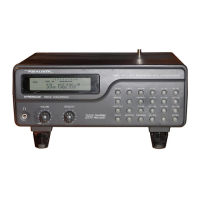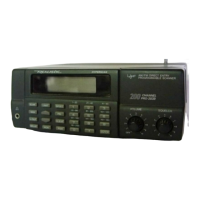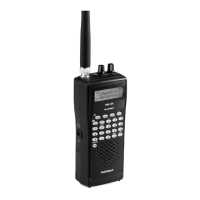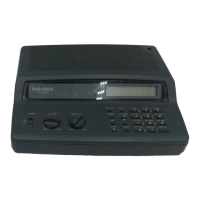PRO-2037 Programmable Scanner 200-0461 Understanding the Scanner http://support.radioshack.com/support_electronics/doc37/37890.htm
2 of 3 7/29/2007 11:47 AM
SEARCH - appears during a limit search
(-L- also appears) or a direct
search (-d- also appears).
Up or Down Arrow also appear to
indicate the search direction.
PRIORITY - appears when you turn on the
priority channel feature.
P - appears when the scanner is set
to the priority channel.
MONITOR - appears when you listen to a
monitor memory.
BANK - bars to the right of this
indicator show which memory
banks are turned on for
scanning.
CH - appears with a number (1-200) to
show which of the scanner's
200 channels it is tuned to.
FM or AM - shows whether the scanner is set
to the FM or AM mode. If FM or
AM flashes, you manually
selected the mode.
DELAY - appears when the scanner stops
at a channel you programmed for
a 2-second delay.
PROGRAM - appears when you program
frequencies into the scanner's
channels.
LOCK-OUT - appears when you lock out a
channel or manually select a
locked-out channel.
UNDERSTANDING MEMORY
You can store frequencies into either a permanent memory location, called
a channel, or a temporary memory location, called a monitor memory. You
can store up to 200 channels and 10 monitor memories.
CHANNEL-STORAGE BANKS
To make it easier to identify and select the channels you listen to most
often, channels are divided into 10 channel-storage bank to group
frequencies, such as those used by the police department, fire department,
ambulance services, or aircraft.
For example, there might be three or four police departments in your area,
each using several different frequencies. Additionally, there might be
other law enforcement agencies such as state police, county sheriffs, or
SWAT teams that use their own frequencies. You could program all law
enforcement frequencies starting with Channel 1 (the first channel in
Bank 1), then program the fire department, paramedic, and other public
safety frequencies starting with Channel 21 (the first channel in Bank 2).
MONITOR MEMORIES
The scanner also has 10 monitor memories. You can use these memories to
temporarily store frequencies while you decide whether or not to save them
in channels. This is handy for quickly storing an active frequency when

